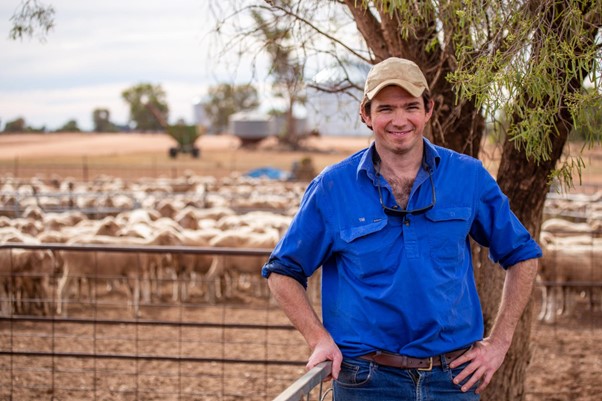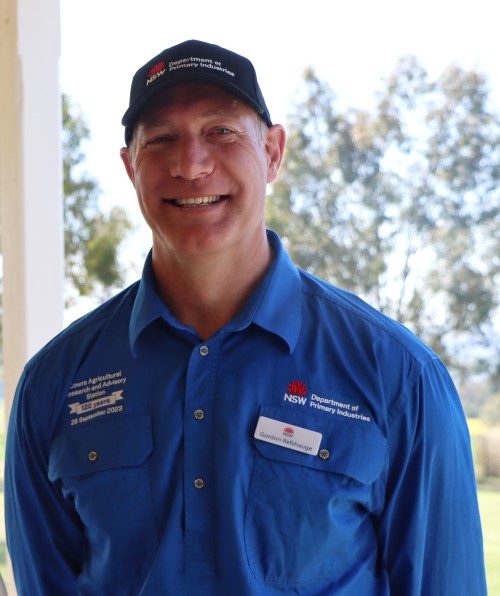Sheep webinars
Speaker: Dr Gordon Refshauge
Gordon is a Senior Research Scientist with DPIRD NSW with 20 years research experience. He is based at the Agricultural Research and Advisory Station in Cowra.
His research focuses on sheep and goat reproduction but studies he has worked on include aspects of nutrition, technology development, management, disease case studies, meat science and genetics.
This webinar covers:
- Identifying the key factors affecting sheep fertility rates.
- Implementing effective nutritional strategies to improve pre-mating conditions for ewes and rams.
- Utilising pregnancy scanning data to enhance your medium-term planning and overall flock productivity
Date and time: 7-8pm AEDT, 12 March 2025

Speaker: Tim Gole – For Flocks Sake
Tim Graduated from the University of Queensland in 2006. He has completed his membership with the Australian and New Zealand College of veterinary Scientists in Sheep medicine and achieved a graduate certificate in Agribusiness.
Having worked in England and Scotland as well as across Queensland and NSW from the Gulf down to Finlay, Tims second proudest achievement was being a cofounder of the Western Rivers Veterinary Group in Warren and Nyngan 2013 and the North Australian Veterinary Group Cloncurry 2015. Combined these vet business provided production animal services across 4 states.
Recognising a need in the sheep industry for dedicated Veterinary based advice and production services. Tim saw the light, got out of vet practice and founded his proudest achievement: For Flocks Sake Pty Ltd based in Dubbo with the sole purpose of educating and assisting producers to grow their best sheep through Health genetics and data
This webinar covers:
- Ram team tracking
- condition scoring
- booking in the preg scanner
- joining length
- refining/setting a breeding objective before ram sale season.
Date and time: 7-8pm AEDT, 12 February 2025
Anne Collins is the principal of AC Ag Consulting and has nearly 30 years’ experience working with livestock industries in Australia.
Anne’s particular areas of interest include sheep breeding and genetics, reproduction efficiency, technology adoption and data management. She recently completed a three-year MLA funded PDS project “Maximising Dorper Reproductive Performance”, working with a group of producers on the far west coast of SA to find ways to increase the reproductive efficiency of their self-replacing Dorper flocks.
In 2022, Anne joined forces with the University of Adelaide to successfully tender for the MLA Donor Company funded project, “Quantifying and improving reproductive performance of shedding sheep”.
This webinar covers:
- Understanding weaning rate as a key profit driver in a shedding sheep business
- Fit to join assessment of ewes and rams
- Cost effective management practices to increase reproduction rate.
Date and time: 8 May 2024, 7:00pm AEDT
Date: Wednesday March 16th 2022
Time: 8.00pm AEDT
Presenters: Colin Trengove
Details: Trace mineral deficiencies affecting sheep in Australia commonly occur in late winter to spring and in above average rainfall seasons these deficiencies can occur earlier. Join Colin Trengove from the University of Adelaide to discuss:
- What influences trace mineral deficiencies?
- How do they impact ewes at lambing?
- What practices can be implemented to minimise or treat these deficiencies?
Next Steps:
- Making More From Sheep resources
- Lifetime Ewe Management course
- Profitable Grazing Systems courses e.g. Lifting Lamb Survival, Improving Ewe Performance
- Consider hosting a Producer Demonstration Site.
Sue Hatcher from Makin Outcomes will assist webinar participants in:
- understanding the key issues affecting weaner survival and performance and
- guide them through developing targets for growth for this key cohort of sheep.
This webinar will discuss factors that contribute to weaner mortality and ill thrift, and provides practical pathways for improving performance.
As a wet winter approaches producers will be monitoring for signs of lameness in their flock. Professor Bruce Allworth will be taking the audience through what the different types of foot issues are and how to prevent and treat them to minimise production losses.
Australian sheep producers have lifted lamb survival rates significantly over the past decade, however there is always room for further improvement. Nathan Scott will provide an overview of the key factors affecting lamb survival and give practical tips on how to improve lamb survival in your own flock. Nathan will delve into :
- Strategies to improve lamb survival and reduce ewe wastage
- Best practice management for lambing
- Prepare ewes and their lambing paddocks to enable better lambing.
Date: Wednesday, 27 April 2022
Time: 8.00pm AEDT
Presenter: Dr Colin Trengrove
Details: As the sheep industry strives to optimise lamb growth rates, meeting trace minerals requirement remains a key production consideration. Join Dr Colin Trengrove from the University of Adelaide to discuss:
- When and why do we see lamb mineral deficiencies?
- How to recognise and identify trace mineral deficiencies?
- What practices can be implemented to minimise or treat these deficiencies?
Next Steps:
- Making More From Sheep resources
- Lifetime Ewe Management course
- Profitable Grazing Systems courses e.g. Lifting Lamb Survival, Improving Ewe Performance
- Consider hosting a Producer Demonstration Site.
Date: Wednesday December 1st 2021
Time: 8.00pm AEDT
Presenters: Peta Bradley and Angus Burnett-Smith
Details: This webinar panel consisting of genetic and visual animal selection experts will provide an overview as to what to look for when purchasing breeding stock. Peta Bradley of MLA will delve into genetic evaluation of stock whilst Angus Burnett-Smith will touch on the visual aspect of selection.
The following information and associated links will be available on the MLA website with the webinar recording.
- MLA’s Genetics Hub provides information to get started understanding breeding values and indexes.
- The Bred Well Fed Well course.
- Profitable Grazing Management courses e.g. Building Better Breeders.
This recent MLA project focused on investigation flock rebuild strategies that enable producers to assess the most viable and economic flock recovery plan based on business goals, risk appetite and current flock base. Forbes Brian from The University of Adelaide will take the audience through the outcomes from the project, including:
- The economics of different flock rebuild strategies
- What the results mean in a regional context
- What barriers were identified to the red meat industry
Next steps and relevant resources:
- Making More From Sheep resources
- Lifetime Ewe Management course
- Profitable Grazing Management courses e.g. Lifting Lamb Survival, Improving Ewe Performance.
Breeding ewes are an important asset for sheep enterprises, with late pregnancy and lambing the highest risk period for mortalities.
- Mary McQuillan will share the findings from recent Australian studies uncovering the major causes of ewe mortality in the lead up to and at the time of lambing.
- Our expert panel will then discuss the ‘big hitters’ affecting ewes in different production systems, and
- delve into the tools available for sheep enterprises to manage risk and optimise survival of ewes and their lambs.
Caroline Jacobson of Murdoch University shares new research on the hidden costs associated with difficult birth (dystocia) for Australian sheep enterprises.
- How to improve lamb and ewe survival rates
- How you can assess the impacts of dystocia for your own enterprise, and
- Measures with the most potential to improve farm profit and animal welfare.
Aggregate Consulting advisor Hilary Beech updates the industry on key benchmarks of prime lamb enterprises from 2019/20.
- How did prime lamb enterprise financial performance fair in the 2019/20 drought
- What were the key profit drivers for prime lamb enterprises for 2019/20
- What are the take-home messages from 2019/20 benchmark data.
Bruce discusses the nature of ovine brucellosis, it’s effects on the reproductive performance of sheep flocks. Bruce covers:
- How B.Ovis works
- How it costs you money
- How to test for it
- What to do if you have B.ovis
- What to do if you don’t have it and want to prevent it.
Tom Keogh summarises current trial work on feeding regimes targeting pre and post weaning growth rates in lambs, this webinar covers:
- What drives growth rates in lambs both pre and post weaning
- The effectiveness of creep feeding
- Preparation and adaptation of lambs to high concentrate diets.
In this webinar Jess Richards demonstrates how to adjust the percentage of merino ewes mated to terminals whilst maintaining a productive flock structure. Jess will also:
- Demonstrate the number of merino ewes that can be mated to terminals whilst maintaining a self-replacing merino flock.
- Look at opportunities for selections of ewes to join to terminals
- Discuss the impact of additional traits on a dual selection strategy
- Highlight the importance of ram selection.
Dr John Webb Ware discusses the impacts on retaining older aged ewes to build flock numbers, including:
- How do breed types differ in response to management in older age groups, ie. merino ewes vs crossbred ewes?
- What are the impacts of the change in flock structure on the production system?
- What are the key considerations in managing the health of older ewes?
Dr Bruce Allworth of Charles Sturt University discusses when is the best time to wean crossbred lambs off crossbred ewes. Bruce also covers:
- When do ewes cease lactation?
- Is 14 weeks still the best option for weaning if you lamb in July?
- What are the factors to consider when determining your weaning date?
Dr Matt Playford of Dawbuts Animal Health updates southern sheep producers on the current status of drench resistance in worms, including:
- Update producers on effective drench combinations
- Discuss best practice to delay the onset of drench resistance
- Cover how to protect your property from a biosecurity point of view.
Paul Nilon from Nilon Farm Health discusses the different causes, impacts and treatments of infections causing abortions in sheep. Including;
- Identifying there is a problem - how do we know?
- Campylobacter, Toxoplasmosis and Listeriosis - what is expected and what can we do about them?
- Other causes of abortions.
Neal Fogarty from Neal Fogarty Consulting discusses the effects of heterosis in prime lamb flocks. Neal delves into:
- Where hybrid vigour expresses itself in sheep and how much productivity is gained in these areas
- How much hybrid vigour is gained from a simple crossbred system?
- How to integrate selection and heterosis to maximise performance?
Time of lambing is a balance between a number of production and market factors which need to be weighed up to maximise profit in a lamb enterprise. John Webb-Ware from the University of Melbourne takes us through a range of scenarios to determine the optimal lambing time for your lamb business. This webinar outlines:
- Why the time of lambing is important for a prime lamb enterprise
- How to maximise value and quantity of lamb produced
- How to determine the most profitable system with the lowest risk for your region.




